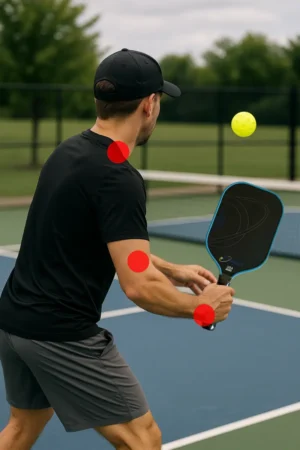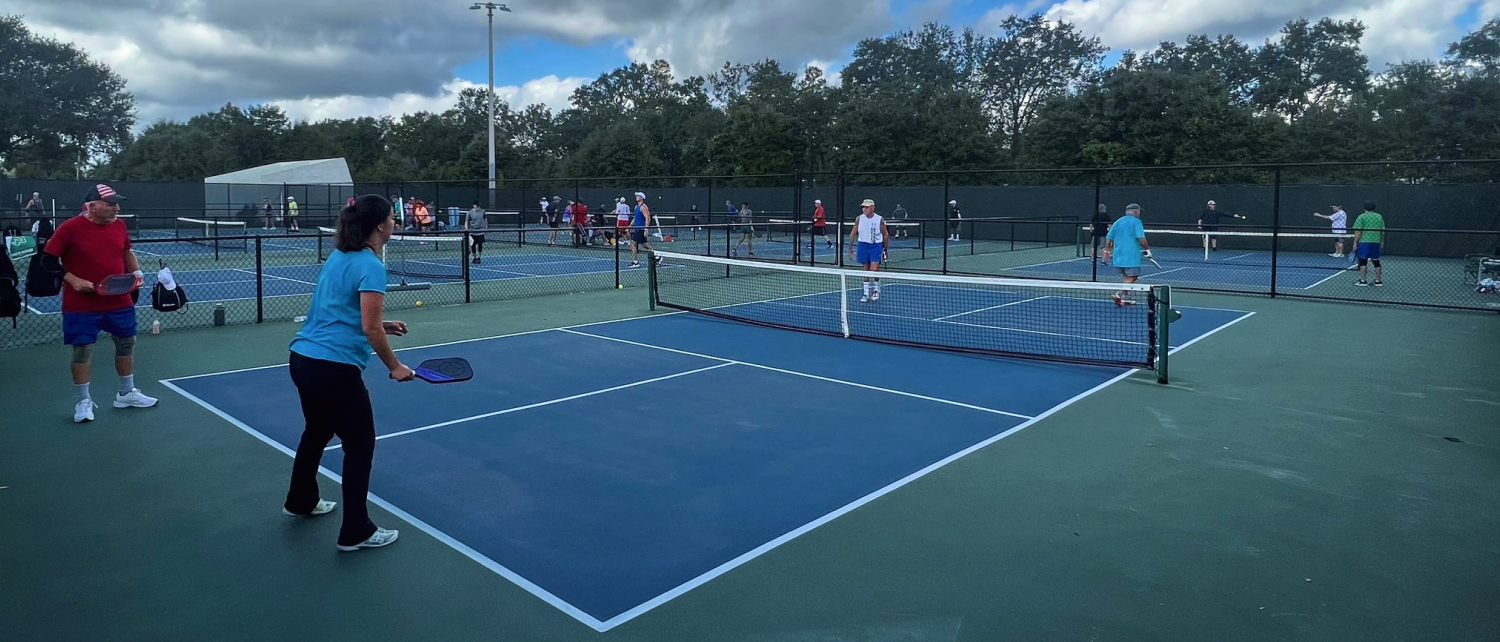Your cart is currently empty!

Pickleball has grown into one of the most popular sports across all age groups. Its accessible learning curve and fast pace make it appealing for beginners and experienced athletes alike. However, as participation increases, so do reports of discomfort or repetitive strain in the elbow, shoulder, and wrist. Many of these issues arise not from overexertion but from improper technique. When players rely too heavily on their arms, lack stable mechanics, or use inefficient footwork, the body compensates in ways that overload the joints. Developing proper technique is the strongest foundation for preventing injury, improving performance, and sustaining long-term enjoyment of the game.
Understanding Why Technique Matters
Pickleball is a sport driven by timing, precision, and controlled power. Unlike tennis, which uses full swings and larger court coverage, pickleball relies on finesse and quick reactions. The smaller paddle, lower ball bounce, and compact court invite players to take shortcuts with their mechanics. Unfortunately, these shortcuts often lead to uneven loading of the joints.
When technique is incorrect, the smaller stabilizing muscles of the arm and shoulder absorb the majority of the force. Over time, this repeated stress leads to inflammation, tendon irritation, muscle imbalance, and chronic discomfort. Good technique redistributes the workload to larger muscle groups, improves efficiency, and reduces unnecessary strain on vulnerable joints.
Preventing Elbow Injuries: Reducing the Risk of Pickleball Elbow
Elbow pain is one of the most common issues players face. “Pickleball elbow” closely resembles tennis elbow and involves irritation of the tendons that extend the wrist and stabilize the forearm. This irritation is typically caused by overuse or improper mechanics.
Key Technique Adjustments That Protect the Elbow
1. Maintain a relaxed grip.
One of the most common mistakes is gripping the paddle too tightly. A tight grip creates excessive tension through the forearm muscles and places direct strain on the elbow tendons. Using a relaxed, controlled grip allows the paddle to absorb more impact.
2. Keep the wrist neutral.
Frequent wrist snapping or flicking places direct stress on the elbow. Maintaining a stable, neutral wrist position transfers the workload into the shoulder and torso rather than the smaller joints.
3. Engage your body, not just your arm.
Players who “arm” their shots often overload the elbow. Instead, rotate the torso, shift your weight, and use your legs to drive the shot. These large muscle groups are built for power, and using them correctly protects the elbow from unnecessary strain.
4. Smooth, controlled swings.
Jerky or abrupt swings increase impact forces. Smooth mechanics reduce shock through the arm, improving both safety and shot consistency.
Protecting the Shoulder: Reducing Strain on the Rotator Cuff
The shoulder is a highly mobile joint supported by small stabilizing muscles. Poor technique, overreaching, and inefficient body positioning can overload these muscles and lead to pain or irritation.
Technique Habits That Support Shoulder Health
1. Rotate your torso when swinging.
Shoulder injuries often occur when players try to generate power by swinging their arm independently. Using torso rotation distributes force across the entire body and protects the shoulder.
2. Avoid extreme overhead motions.
Many players reach too far behind their body for overhead shots, stressing the rotator cuff. Instead, focus on proper positioning and footwork to meet the ball comfortably in front.
3. Keep the paddle out in front.
A properly positioned paddle reduces sudden reaching or shoulder extension. This stable “ready position” enhances reaction time and reduces awkward angles.
4. Use compact swings.
Pickleball does not require large tennis-style swings. Keeping movements compact reduces strain and improves control during fast exchanges at the kitchen line.
Wrist Protection: Stability Over Flicking
The wrist absorbs a significant amount of repetitive stress, especially in players who try to generate spin or speed through wrist motion alone. Unlike tennis rackets, pickleball paddles require very little wrist force to control the ball.
Wrist Technique to Reduce Injury Risk
1. Keep the wrist firm and neutral.
A stable wrist position ensures the larger muscles in the arm and shoulder take the load.
2. Avoid exaggerated topspin motions unless trained.
Players sometimes mimic tennis topspin without understanding the mechanics. This leads to over-flexion or over-extension of the wrist, which raises injury risk.
3. Focus on paddle angle instead of wrist flicking.
Controlling ball placement through paddle angle is safer and more consistent.
4. Generate power from rotation rather than wrist movement.
If your power is coming from the wrist, you are working too hard and risking fatigue-based injury.
The Importance of Footwork and Positioning in Preventing Upper-Body Injuries
Most upper-body issues originate from poor lower-body positioning. When players reach awkwardly for the ball because their feet are slow or they fail to reposition, the elbow, shoulder, and wrist compensate. Over time, these compensations lead to strain.
Good Footwork Prevents Overreaching
Key habits include:
- Taking small, quick adjustment steps
- Staying balanced with knees slightly bent
- Maintaining a wide, athletic base at the non-volley zone
- Using proper split-steps to stay ready for incoming shots
Proper footwork ensures you strike the ball in a comfortable position instead of twisting or stretching into risky angles.
Warm-Up Routines That Help Prevent Injury
A thorough warm-up increases blood flow, improves joint mobility, and enhances muscle activation. This preparation can dramatically reduce the risk of strains.
Effective Pickleball Warm-Up Components
- Dynamic arm circles to activate the shoulders
- Wrist mobility rotations to prepare the wrist joint
- Light forearm stretching to loosen the elbow tendons
- Side steps and shuffle drills to activate the legs
- Mini-dinks and soft volleys to ease into paddle mechanics
- Shadow swings to reinforce smooth, warm movement patterns
A proper warm-up should last at least five to eight minutes before playing intensely.
Recovery Routine for Long-Term Joint Health
Recovery is just as important as technique. When muscles and tendons are fatigued, they lose the ability to stabilize joints effectively.
Recommended Post-Play Recovery Practices
- Gentle stretching for the shoulder, forearm, and wrist
- Light icing if you feel inflammation in any joint
- Using massage tools to release tight forearm muscles
- Hydration to support cellular repair
- Adequate rest between intense sessions
Players who invest in recovery typically experience fewer flare-ups and more consistent performance.
Choosing the Right Paddle to Protect Your Joints
Equipment plays a surprisingly large role in joint health. The wrong paddle can magnify impact forces and lead to elbow and wrist strain.
Factors to Consider
1. Paddle weight
A paddle that is too light forces players to swing harder, creating more strain. A slightly heavier paddle can absorb more of the impact.
2. Grip size
A grip that is too small causes over-gripping, which strains the forearm. A properly sized grip allows a relaxed hand position.
3. Paddle core and material
Polymer cores tend to provide softer impact absorption, which is friendlier to the joints.
4. Vibration dampening
Some paddles reduce vibration better than others, which can be beneficial for players with a history of elbow or wrist pain.
Why Taking Lessons Helps Prevent Injury
A qualified coach can identify subtle mechanical flaws that players often do not feel or notice. Correcting these small mistakes early prevents them from developing into chronic problems.
Common issues a coach can spot include:
- Overuse of the wrist on volleys
- Arm-only swings
- Poor ready position
- Excessive grip tension
- Incorrect foot placement
- Risky mechanics on overheads
- Imbalanced follow-throughs
Regular lessons help reinforce healthy movement patterns that protect the body and enhance performance.
Taking Lessons With Coach Igor: Building Safe, Efficient, and Consistent Technique
While players can pick up basic pickleball skills quickly, refining proper technique requires guidance from a trained coach. Small mechanical errors—such as a late contact point, over-gripping the paddle, swinging with only the arm, or positioning the wrist incorrectly—can significantly increase stress on the elbow, shoulder, and wrist. Coach Igor focuses on efficient movement patterns that protect the joints while improving control and confidence on every shot.
Lessons emphasize balanced footwork, smooth swing mechanics, proper paddle path, body-driven power, and strategic positioning at the non-volley zone. This approach not only reduces strain but also elevates overall performance. Players who train with Coach Igor consistently report more accuracy, less fatigue, and fewer aches during and after play. His method ensures long-term progress while prioritizing technique that keeps players healthy and active on the court.
The Bottom Line
Staying injury-free in pickleball requires more than passion and enthusiasm. Proper technique is the key to protecting the elbow, shoulder, and wrist from unnecessary strain. When players use balanced mechanics, stable wrist positioning, controlled swings, efficient footwork, and thoughtful recovery routines, they reduce their injury risk significantly. Whether you are a beginner or an advanced competitor, developing strong technique is the most reliable path to long-term improvement, comfort, and enjoyment on the court.
FAQs
1. What is the most common injury caused by poor technique in pickleball?
Elbow irritation, often called “pickleball elbow,” is one of the most common problems. It occurs when players grip the paddle too tightly or use wrist-driven swings that overload the forearm muscles and tendons.
2. Can poor footwork really cause upper-body injuries?
Yes. When players reach instead of moving their feet, their joints are forced into uncomfortable positions. This creates strain on the wrist, elbow, and shoulder. Good footwork helps maintain balance and safe body alignment.
3. Does paddle weight matter for injury prevention?
It does. A paddle that is too light requires more forceful swinging, which increases joint stress. A properly weighted paddle absorbs impact and reduces strain, especially in the elbow and wrist.
4. Can beginners avoid injuries even if they lack athletic experience?
Absolutely. Beginners who learn proper technique early are far less likely to develop overuse injuries. Simple adjustments to grip, stance, and swing mechanics make a meaningful difference.
5. How often should players warm up before playing?
A warm-up of at least five to eight minutes is recommended. Light movement, arm circles, forearm mobility, and short dinks prepare the joints and muscles for more intense play.
6. How can lessons help reduce pain or discomfort during pickleball?
A coach can identify mechanical issues that cause unnecessary strain. Correcting stroke patterns, paddle position, footwork, and body rotation helps remove pressure from vulnerable joints while improving performance.
References
- Greiner N., et al. “Pickleball: Injury Considerations in an Increasingly Popular Sport.” PMC (2019). – https://www.ncbi.nlm.nih.gov/pmc/articles/PMC6913863/
- Myers B., Hanks J. “Overuse Injuries and Epicondylalgia in Recreational Pickleball Players.” International Journal of Racket Sports Science (2023). – https://journal.racketsportscience.org/index.php/ijrss/article/view/108
- Herzberg S.D., et al. “Evaluation of Pickleball‑Related Injuries at a Single Institution.” SAGE Journals (2025). – https://journals.sagepub.com/doi/10.1177/23259671251316997
- Davis V. “Upper Extremity Overuse Injuries in Racket and Paddle Sports.” (2025). – https://scholarworks.calstate.edu/downloads/0g354q60f
- Sparling K. “A radiologic review of common pickleball‑related injuries.” ScienceDirect (2025). – https://www.sciencedirect.com/science/article/abs/pii/S0899707125002177
Picture Source: AI-generated
by






